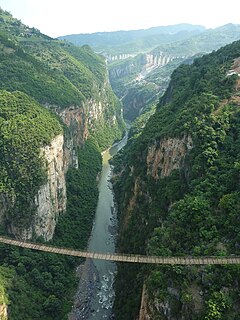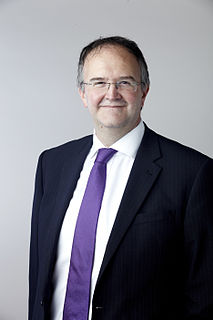
Spearmint, also known as garden mint, common mint, lamb mint and mackerel mint, is a species of mint, Mentha spicata, native to Europe and southern temperate Asia, extending from Ireland in the west to southern China in the east. It is naturalized in many other temperate parts of the world, including northern and southern Africa, North America and South America. It is used as a flavouring in food and herbal teas. The aromatic oil, called oil of spearmint, is also used as a flavouring and sometimes as a scent.

Eggplant, aubergine or brinjal is a plant species in the nightshade family Solanaceae. Solanum melongena is grown worldwide for its edible fruit.

Boesenbergia rotunda, Thai กระชาย krachai, commonly known as Chinese keys, fingerroot, lesser galangal or Chinese ginger, is a medicinal and culinary herb from China and Southeast Asia. In English, the root has traditionally been called fingerroot, because the shape of the rhizome resembles that of fingers growing out of a center piece.

Allium tuberosum is a species of plant native to the Chinese province of Shanxi, and cultivated and naturalized elsewhere in Asia and around the world.

Mudflats or mud flats, also known as tidal flats, are coastal wetlands that form in intertidal areas where sediments have been deposited by tides or rivers. A recent global analysis suggested they are as extensive globally as mangroves. They are found in sheltered areas such as bays, bayous, lagoons, and estuaries; they are also seen in freshwater lakes and salty lakes alike, wherein many rivers and creeks end. Mudflats may be viewed geologically as exposed layers of bay mud, resulting from deposition of estuarine silts, clays and aquatic animal detritus. Most of the sediment within a mudflat is within the intertidal zone, and thus the flat is submerged and exposed approximately twice daily.

Gesneriaceae, the gesneriad family, is a family of flowering plants consisting of about 152 genera and ca. 3,540 species in the tropics and subtropics of the Old World and the New World, with a very small number extending to temperate areas. Many species have colorful and showy flowers and are cultivated as ornamental plants.

Flora is all the plant life present in a particular region or time, generally the naturally occurring (indigenous) native plants. The corresponding term for animal life is fauna. Flora, fauna, and other forms of life, such as fungi, are collectively referred to as biota. Sometimes bacteria and fungi are also referred to as flora, as in the terms gut flora or skin flora.

Assam tea is a black tea named after the region of its production, Assam, India. Assam tea is manufactured specifically from the plant Camellia sinensis var. assamica (Masters). Assam tea is indigenous to Assam. Initial efforts of planting Chinese varieties in Assam soil did not succeed. Although Assam tea is now mostly grown at or near sea level and is known for its body, briskness, malty flavour, and strong, bright colour. Assam teas, or blends containing Assam, are often sold as "breakfast" teas. For instance, Irish breakfast tea, a maltier and stronger breakfast tea, consists of small-sized Assam tea leaves.

The plant tribe Phaseoleae is one of the subdivisions of the legume subfamily Faboideae, in the unranked NPAAA clade. This group includes many of the beans cultivated for human and animal food, most importantly from the genera Glycine, Phaseolus, and Vigna.

Rheum officinale, the Chinese rhubarb, or Indian rhubarb is a rhubarb from the family Polygonaceae native to China. In Chinese it is called yào yòng dà huáng, literally meaning medicinal rhubarb.
Cicada lore and mythology is rich and varied as there are c. 2500 species of cicada throughout the world, many of which are undescribed and remain a mystery to science. Cicada has been prized as a delicacy, and are famed throughout the world for their song.

Helicia is a genus of 110 species of trees and shrubs, constituting part of the plant family Proteaceae. They grow naturally in rainforests throughout tropical South and Southeast Asia, including India, Sri Lanka, Indochina, Peninsular Malaysia to New Guinea and as far south as New South Wales.

Beipan River is a river in Guizhou and Yunnan provinces, China, and part of the great Pearl River basin.

Buddleja nivea is a vigorous shrub endemic to western China, evergreen in the wild, but deciduous in cultivation in the UK. The plant was discovered by Wilson in the Yangtze basin at altitudes of 700 – 3,600 m. Introduced to cultivation in 1901, it was named by Duthie in 1905. Several plants similar to the species but originally treated as species and varieties in their own right have now been sunk as B. nivea.

Jardine Matheson Holdings Limited is a Hong Kong-based Bermuda-domiciled British multinational conglomerate. It has a primary listing on the London Stock Exchange and secondary listings on the Singapore Exchange and Bermuda Stock Exchange. The majority of its business interests are in Asia, and its subsidiaries include Jardine Pacific, Jardine Motors, Hongkong Land, Jardine Strategic Holdings, Dairy Farm, Mandarin Oriental Hotel Group, Jardine Cycle & Carriage and Astra International. It set up the Jardine Scholarship in 1982 and Mindset, a mental health-focused charity, in 2002.

Nicholas José Talbot FRS FRSB is Group Leader and Executive Director at The Sainsbury Laboratory in Norwich.
Yude Pan is a senior research scientist with the Climate, Fire, and Carbon Cycle Sciences group of the Northern Research Station, USDA Forest Service, and a Senior Investigator of the Harvard Forest at Harvard University. Her work is in the fields of Ecosystem ecology and Global Change Biology. She studies terrestrial ecosystems and how environmental stressors affect complex interactions within those ecosystems. Much of her research focuses on forest ecosystems and how they relate to the carbon cycle as a whole, as well as forecasting complex effects of land use, climate change and air pollution on forest ecosystems.
Helicia nilagirica is a tree of the Proteaceae family. It grows from Thailand across Mainland Southeast Asia to Yunnan, Zhōngguó/China and over to Nepal. It is a source of wood, a pioneer reafforestation taxa, and an ethnomedicinal plant.
Beccarinda is a genus of flowering plants belonging to the family Gesneriaceae.
Briggsiopsis is a genus of flowering plants belonging to the family Gesneriaceae.














